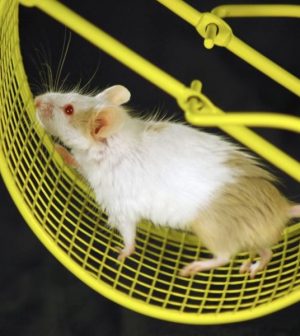- Navigating Your Midlife Crisis: Embracing New Possibilities
- City Raccoons Showing Signs of Domestication
- Mapping the Exposome: Science Broadens Focus to Environmental Disease Triggers
- One Week Less on Social Media Linked to Better Mental Health
- Your Brain Changes in Stages as You Age, Study Finds
- Some Suicide Victims Show No Typical Warning Signs, Study Finds
- ByHeart Formula Faces Lawsuits After Babies Sickened With Botulism
- Switch to Vegan Diet Could Cut Your Greenhouse Gas Emissions in Half
- Regular Bedtime Does Wonders for Blood Pressure
- Dining Alone Could Mean Worse Nutrition for Seniors
In Mice, Gene Therapy Helps Restore Movement After Spinal Cord Injury

Gene therapy has restored mobility in mice with completely severed spinal cords, researchers report.
The mice regained the ability to walk, with gait patterns resembling those of mice that resumed walking naturally after only partial cord injuries, the investigators found.
This happened because the new gene therapy used techniques to not only repair spinal cord tissue, but also to direct the repairs in a way that would restore mobility, the study authors said.
“Five years ago, we demonstrated that nerve fibers can be regenerated across anatomically complete spinal cord injuries [when the spinal cord is completely severed],” said senior researcher Mark Anderson. He is director of Central Nervous System Regeneration at the Swiss research and treatment center NeuroRestore.
“But we also realized this wasn’t enough to restore motor function, as the new fibers failed to connect to the right places on the other side of the lesion,” Anderson said in a Swiss Federal Institute of Technology news release.
Partial damage of human and mouse spinal cords can cause initial paralysis, but spontaneous recovery of motor function most often follows.
This is not true of a complete spinal cord injury. Natural repair doesn’t occur, and the patient remains paralyzed, the study authors explained.
Recovery after severe spinal cord injuries requires strategies that promote the regeneration of nerve fibers, but researchers have struggled to find the right combination to promote successful regrowth.
This group of scientists ran in-depth analyses to identify the specific type of neuron involved in the natural repair that occurs after a partial spinal cord injury.
The analysis revealed that specific axons — thin fibers that connect neurons — not only must regenerate, but must reconnect to their natural targets to restore motor function.
Based on this discovery, the researchers developed a multipronged gene therapy.
The team activated the growth of those identified neurons in mice to regenerate their nerve fibers, as well as promoting specific proteins to support the neurons’ growth through scar tissue.
The researchers also used guidance molecules to attract the regenerating nerve fibers to their natural targets below the injury.
The findings were published Sept. 21 in the journal Science. Research in animals doesn’t always pan out in humans.
“We expect that our gene therapy will act synergistically with our other procedures involving electrical stimulation of the spinal cord,” said senior researcher Grégoire Courtine, co-head of NeuroRestore. “We believe a complete solution for treating spinal cord injury will require both approaches — gene therapy to regrow relevant nerve fibers, and spinal stimulation to maximize the ability of both these fibers and the spinal cord below the injury to produce movement.”
More information
The U.S. National Institute of Neurological Disorders and Stroke has more about spinal cord injury.
SOURCE: Swiss Federal Institute of Technology, Lausanne, news release, Sept. 21, 2023
Source: HealthDay
Copyright © 2025 HealthDay. All rights reserved.










